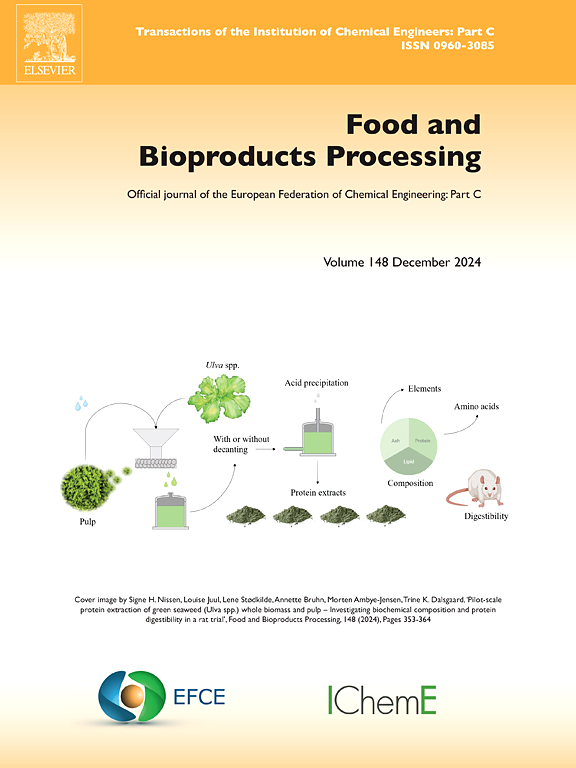Investigation of near infrared and Raman fibre optic process sensors for protein determination in milk protein concentrate
IF 3.5
2区 农林科学
Q2 BIOTECHNOLOGY & APPLIED MICROBIOLOGY
引用次数: 0
Abstract
This study investigated the potential of two fibre optic process sensors based on near infrared (NIR) or Raman spectroscopic technology for protein measurement in milk protein concentrate (MPC). Partial least squares (PLS) models were developed using NIR, Raman, and fusion of NIR and Raman spectra data. Calibration models developed were optimized by selecting different spectral pre-treatment methods and spectral regions. Overall, the three optimal models (NIR, Raman, fused NIR and Raman) yielded R2p values >0.9 and RMSEP values in the range of 0.168–0.185 %. The optimised fusion model outperformed all Raman models and had a similar protein prediction accuracy (R2p = 0.911 and RMSEP = 0.178 %) compared to the optimised NIR model (R2p = 0.917 and RMSEP =0.168 %). Results of the study demonstrated that both NIR and Raman process probes can be used as process analytical technology (PAT) tools for inline protein measurements of MPC post membrane filtration.
用于测定浓缩牛奶蛋白中蛋白质的近红外和拉曼光纤过程传感器的研究
本研究调查了基于近红外(NIR)或拉曼光谱技术的两种光纤过程传感器在牛奶浓缩蛋白(MPC)蛋白质测量中的潜力。利用近红外光谱、拉曼光谱以及近红外光谱和拉曼光谱数据的融合建立了偏最小二乘法(PLS)模型。通过选择不同的光谱预处理方法和光谱区域,对所开发的校准模型进行了优化。总体而言,三个最佳模型(近红外光谱、拉曼光谱、融合近红外光谱和拉曼光谱)的 R2p 值为 0.9,RMSEP 值在 0.168-0.185 % 之间。与优化的近红外模型(R2p = 0.917,RMSEP = 0.168 %)相比,优化的融合模型优于所有拉曼模型,蛋白质预测准确率(R2p = 0.911,RMSEP = 0.178 %)与之相近。研究结果表明,近红外和拉曼过程探针可作为过程分析技术 (PAT) 工具,用于膜过滤后 MPC 的在线蛋白质测量。
本文章由计算机程序翻译,如有差异,请以英文原文为准。
求助全文
约1分钟内获得全文
求助全文
来源期刊

Food and Bioproducts Processing
工程技术-工程:化工
CiteScore
9.70
自引率
4.30%
发文量
115
审稿时长
24 days
期刊介绍:
Official Journal of the European Federation of Chemical Engineering:
Part C
FBP aims to be the principal international journal for publication of high quality, original papers in the branches of engineering and science dedicated to the safe processing of biological products. It is the only journal to exploit the synergy between biotechnology, bioprocessing and food engineering.
Papers showing how research results can be used in engineering design, and accounts of experimental or theoretical research work bringing new perspectives to established principles, highlighting unsolved problems or indicating directions for future research, are particularly welcome. Contributions that deal with new developments in equipment or processes and that can be given quantitative expression are encouraged. The journal is especially interested in papers that extend the boundaries of food and bioproducts processing.
The journal has a strong emphasis on the interface between engineering and food or bioproducts. Papers that are not likely to be published are those:
• Primarily concerned with food formulation
• That use experimental design techniques to obtain response surfaces but gain little insight from them
• That are empirical and ignore established mechanistic models, e.g., empirical drying curves
• That are primarily concerned about sensory evaluation and colour
• Concern the extraction, encapsulation and/or antioxidant activity of a specific biological material without providing insight that could be applied to a similar but different material,
• Containing only chemical analyses of biological materials.
 求助内容:
求助内容: 应助结果提醒方式:
应助结果提醒方式:


